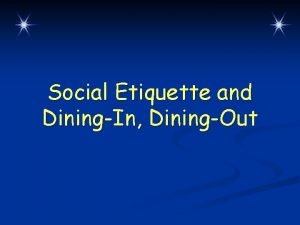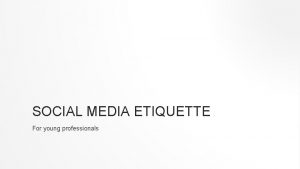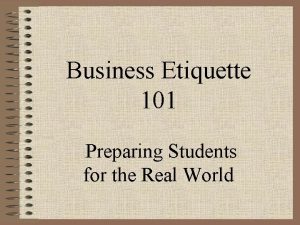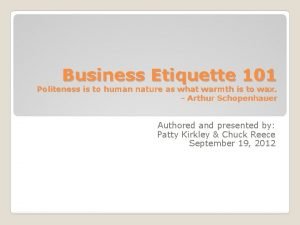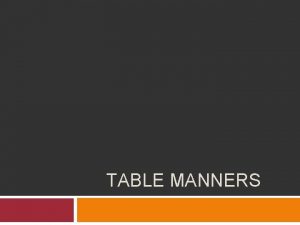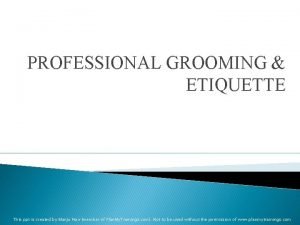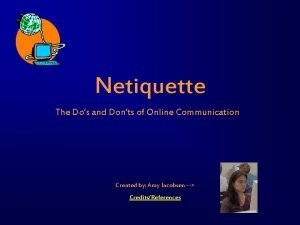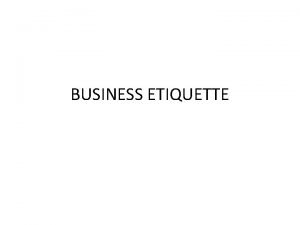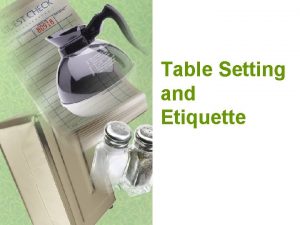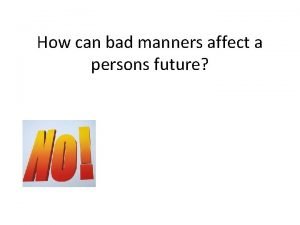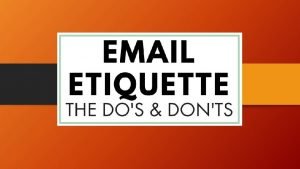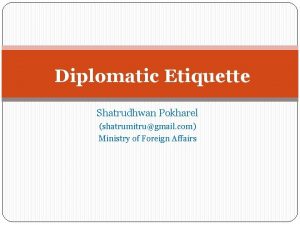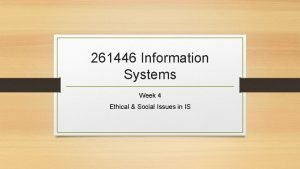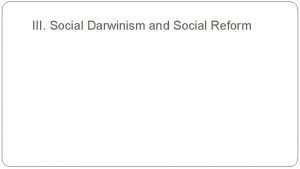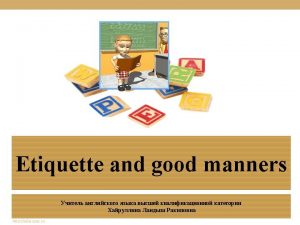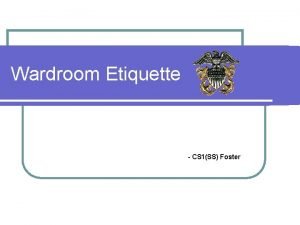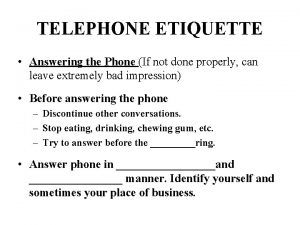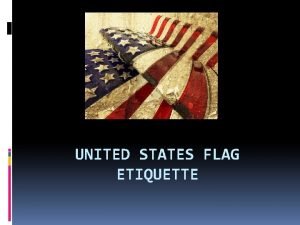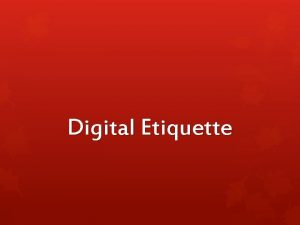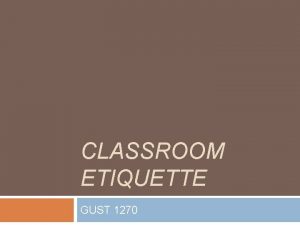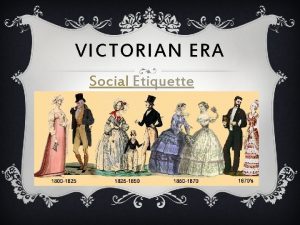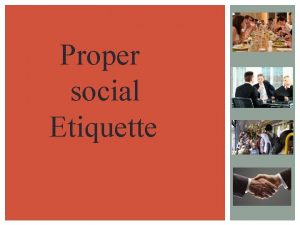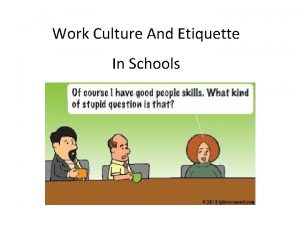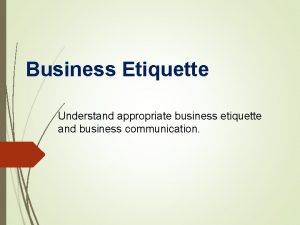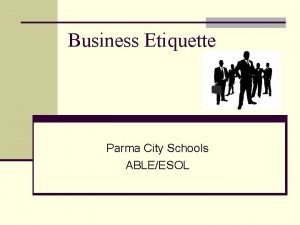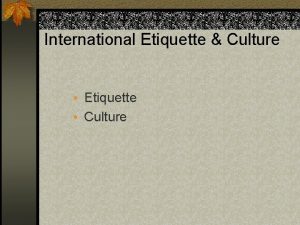Social Etiquette and DiningIn DiningOut How much information




















































- Slides: 52

Social Etiquette and Dining-In, Dining-Out

How much information do you already know about this topic area? A. Expert - I have done a lot of learning in this area already. B. Above average - I have learned some information about this topic. C. Moderate - I know a little about this topic. D. Rookie - I am a blank slate…but ready to learn! 1 1 (LE 100 -C 1 L 6: LQ 1)

When a receiving line is used to welcome guests, who should be the first person in the receiving line? A. B. C. D. The honored guest The host The spouse of the honored guest 1 1 (LE 100 -C 1 L 6: LQ 2)

Lesson Overview Ø Etiquette and manners in formal and informal settings Ø Dining etiquette Ø Handling social invitations Ø Public courtesies Ø Dining-In and Dining-Out Chapter 1, Lesson 6

Vocabulary Questions Slide Index Click any link below to go directly to polling that question. 1. Code of behavior based on rules 4. Someone who holds a high office of a polite society 2. Socially correct ways of acting 5. Name card for a formal dinner 3. Group of people who stand in 6. Take exclusive control line, individually welcome 7. Reply to the hosts to let them guests attending a function know if you can or cannot attend Click here to return to this index.

Vocabulary Questions Slide Index Click any link below to go directly to polling that question. 12. Code of precedence in rank and 8. Artificially dignified 9. Rules for communication using of correct procedure in ceremonies the Internet 10. Formal dinner for members of 13. Companionship 14. Cadet group/wing commander the military only 11. Formal dinner to which non- hosting the Dining-In military guests are invited Click here to return to this index.

Quick Write What do you think are good rules and practices for courtesy and etiquette in the 21 st century? Make a list of five specific things that you do to show courtesy and etiquette in your everyday life. Note to Instructors: Click the Show/Hide Response Display Button Photo Courtesy of Fotolia

Etiquette and Manners are based on: Ø Kindness Ø Respect Ø Thoughtfulness Ø Consideration Ø Good manners are timeless Ø Treat others the same way we want to be treated Ø Chapter 1, Lesson 6 Photo Courtesy of Fotolia

Social Introductions Ø Introductions make everyone feel welcome and part of the group Ø Should be simple, direct, and dignified Ø Should be made automatically and immediately Chapter 1, Lesson 6 Photo Courtesy of Fotolia

Introductions in Formal and Informal Settings A formal reception may include a receiving line Ø A simple, pleasant greeting and a cordial handshake are all that is necessary Ø In informal situations, you may be more casual Ø Chapter 1, Lesson 6 Photo Courtesy of Army Staff Sgt. Carlos M. Burger II/Defense Video & Imagery Distribution System

Methods of Making Introductions Speak names slowly and clearly Ø Apologize and ask the person to restate their name if you forget Ø Put your cell phone away Ø Mention something of common interest to start a conversation Ø Chapter 1, Lesson 6 Photo Courtesy of Fotolia

Shaking Hands Whenever someone extends his or her hand to greet you, always extend your hand in return Ø A proper handshake is brief, firm, and warm Ø Maintain eye contact Ø Chapter 1, Lesson 6 Photo Courtesy of Fotolia

Activity 1: Making Introductions Ø Introduce yourself with the proper verbal greeting and handshake Ø When finished, rotate all the way around until you greet everyone Chapter 1, Lesson 6

Dining Etiquette Proper manners should be used whenever you dine Ø Relaxed politeness is the key Ø Chapter 1, Lesson 6 Photo Courtesy of Fotolia

POW-MIA Ceremony Solemn remembrance for the men and women in all five services who were prisoners of war and are missing in action Ø Recognize the presence, in spirit, of those POWs and MIAs Ø Chapter 1, Lesson 6 Photo Courtesy of Fotolia

A Formal Dining Table Setting Start with the outside piece and work inward Ø The number of pieces of silverware indicates the number of courses Ø Placement indicates the order of courses Ø Chapter 1, Lesson 6 Photo Courtesy of Fotolia

Proper Use of Silverware Hold the fork in your left hand, tines down Ø Secure the food being cut with the knife in your right hand Ø Chapter 1, Lesson 6 Photo Courtesy of Fotolia

Other Rules for Dining Etiquette Eat soup and finger foods properly Ø Use napkins for dabbing lips, catching spills, and covering sneezes Ø Follow basic table manners Ø Use conversation as an important part of social interaction Ø Chapter 1, Lesson 6 Photo Courtesy of Fotolia

When making introductions, if you forget a persons name you should: A. B. C. D. skip introductions. ask a fellow cadet. use a generic title, such as Sir. apologize and ask the persons name. 1 1 (LE 100 -C 1 L 6: LQ 3)

What does the number of pieces of silverware indicate? A. B. C. D. Length of the dinner Formality of the dinner Number of courses Specific menu items 1 1 (LE 100 -C 1 L 6: LQ 4)

Social Invitations RSVP Ø Call or send your reply within two or three days Ø RSVP Regrets Only Ø You are expected unless you notify that you cannot come Ø Chapter 1, Lesson 6 Photo Courtesy of Fotolia

What Should You Wear? Ø Ø Ø Formal Ø Male cadets and male guests Ø Females Informal Ø Males Ø Females Casual Ø Males Ø Females Chapter 1, Lesson 6

Thank-You Note Write a thank-you note within two or three days Ø Be yourself in the note Ø Use sincerity and simplicity Ø Chapter 1, Lesson 6 Photo Courtesy of Fotolia

Activity 2: Etiquette Learning Stations Ø Create an etiquette learning station that teaches others about your topic and how to complete the task Ø Visit the remaining stations to learn about the other tasks Chapter 1, Lesson 6

It is polite to RSVP to an invitation within _____ day(s). A. B. C. D. one two or three four or five seven to ten 1 1 (LE 100 -C 1 L 6: LQ 5)

What is the first rule in social correspondence? A. B. C. D. Candor Sincerity Simplicity Conciseness 1 1 (LE 100 -C 1 L 6: LQ 6)

Proper Netiquette Ø It’s important to use proper netiquette Ø Telephone Courtesy Ø Cell Phones Ø Text Messaging Ø Email Netiquette Chapter 1, Lesson 6 Photo Courtesy of Fotolia

Other Public Courtesies Ø Ø Ø Ø Assisting the Elderly and Disabled Opening Doors for Others Being Responsible for Your Guest Respect for Authorities and Senior Citizens Chewing Gum Waiting in Line Politeness Hygiene and Grooming Chapter 1, Lesson 6 Photo Courtesy of Fotolia

Activity 3: Public Courtesies -Play Role Ø Create a role-play using one of the public courtesy topics showing courteous behavior Ø Share your role-plays with the class Chapter 1, Lesson 6

The Dining-In and Dining-Out The Dining-Out and Military Ball are similar in tradition and activities Ø The Dining-In is an occasion where ceremony and tradition combine with good fellowship Ø Toasting is a universal custom Ø Chapter 1, Lesson 6 Photo Courtesy of MSgt Dale C. Hanson II

The Military Ball Requires cadets to wear formal or semiformal service dress and guests to wear formal attire Ø Careful planning is needed to ensure success Ø Invitations should be sent out as early as possible Ø Chapter 1, Lesson 6 Photo Courtesy of Michael Wetzel/US Air Force JROTC

Avoid using text messaging when informing someone of: A. B. C. D. good news. urgent meetings. greetings from a friend. other information that is easy to understand. 1 1 (LE 100 -C 1 L 6: LQ 7)

Which of the following is important when planning a Military Ball? A. Set a preliminary budget B. Arrange to have a photographer C. Select a band that plays a specific genre of music D. Appoint a publicity chairperson to write news stories during the ball 1 1 (LE 100 -C 1 L 6: LQ 8)

Activity 4: Planning the Dining-Out Ø Complete the worksheet to prepare for the Dining-Out committee meeting Ø Gather in your groups to share and discuss your information Chapter 1, Lesson 6

Summary Ø Etiquette and manners in formal and informal settings Ø Dining etiquette Ø Handling social invitations Ø Public courtesies Ø Dining-In and Dining-Out Chapter 1, Lesson 6

Why is proper etiquette important to learn? Note to Instructors: Click the Show/Hide Response Display Button (LE 100 -C 1 L 6: LQ 9)

Which of the following would be MOST USEFUL to you to continue your learning after this class? A. B. C. D. E. Look up more information about the topic on the Internet. Spend more time reading the text. Work with others to study or review the material. Other Nothing. I feel confident I have learned/mastered this material. 1 1 1 (LE 100 -C 1 L 6: LQ 10)

Next…. Ø Ø Done – social etiquette and -In, Dining-Out Dining Next – note taking and study skills Chapter 1, Lesson 6 Photo Courtesy of Fotolia

A code of behavior or courtesy based on rules of a polite society A. B. C. D. Manners Etiquette Netiquette Dignitary 1 1 (LE 100 -C 1 L 6: VQ 1)

Socially correct ways of acting as shown in widespread customs A. B. C. D. Manners Etiquette Netiquette Dignitary 1 1 (LE 100 -C 1 L 6: VQ 2)

A group of people, including the host and honored guests, who stand in line and individually welcome guests attending a function A. B. C. D. Protocol Netiquette Receiving line President of the Mess 1 1 (LE 100 -C 1 L 6: VQ 3)

A person of importance or someone who holds a high office A. B. C. D. Manners Etiquette Netiquette Dignitary 1 1 (LE 100 -C 1 L 6: VQ 4)

A name card for a formal dinner A. B. C. D. RSVP Place card Receiving line Monopolize 1 1 (LE 100 -C 1 L 6: VQ 5)

To take exclusive ownership or control A. B. C. D. RSVP Place card Receiving line Monopolize 1 1 (LE 100 -C 1 L 6: VQ 6)

You must reply to the hosts to let them know if you can or cannot attend the function to which you've been invited A. B. C. D. RSVP Place card Receiving line Monopolize 1 1 (LE 100 -C 1 L 6: VQ 7)

Stiffly or artificially dignified or formal, pompous, or lofty A. B. C. D. RSVP Stilted Dignitary Comradeship 1 1 (LE 100 -C 1 L 6: VQ 8)

The rules for communication using the Internet or electronic devices A. B. C. D. Manners Etiquette Netiquette Dignitary 1 1 (LE 100 -C 1 L 6: VQ 9)

A formal dinner for members of the military only A. B. C. D. Dining-In Dining-Out Protocol Comradeship 1 1 (LE 100 -C 1 L 6: VQ 10)

A formal dinner to which non-military guests are invited A. B. C. D. Dining-In Dining-Out Protocol Comradeship 1 1 (LE 100 -C 1 L 6: VQ 11)

A code of precedence in rank and status and of correct procedure in ceremonies; a form of etiquette observed in ceremonies; a combination of good manners and common sense that facilitates effective communication. A. B. C. D. Dining-In Dining-Out Protocol Comradeship 1 1 (LE 100 -C 1 L 6: VQ 12)

Companionship A. B. C. D. Dining-In Dining-Out Protocol Comradeship 1 1 (LE 100 -C 1 L 6: VQ 13)

Usually the cadet group/wing commander hosting the Dining-In A. B. C. D. Protocol Netiquette Receiving line President of the Mess 1 1 (LE 100 -C 1 L 6: VQ 14)
 How much
How much To whom much is given much is expected meaning
To whom much is given much is expected meaning How much is too much plagiarism
How much is too much plagiarism Social graces meaning
Social graces meaning What is the first rule in social correspondence?
What is the first rule in social correspondence? Social media etiquette for college students
Social media etiquette for college students Watch business etiquette 101: social skills for success
Watch business etiquette 101: social skills for success Business etiquette 101: social skills for success indireme
Business etiquette 101: social skills for success indireme Etiquette meaning
Etiquette meaning Apa itu social thinking
Apa itu social thinking Social thinking social influence social relations
Social thinking social influence social relations Social darwinism vs social gospel
Social darwinism vs social gospel Copyright
Copyright Manners and etiquette vocabulary
Manners and etiquette vocabulary Grooming ppt
Grooming ppt What are the dos and donts of online interaction
What are the dos and donts of online interaction Grooming body language
Grooming body language Code of diplomatic etiquette and precedence
Code of diplomatic etiquette and precedence Pulpit etiquette and protocol
Pulpit etiquette and protocol Define dias etiquette
Define dias etiquette Why is email etiquette important
Why is email etiquette important French table setting
French table setting Pride and prejudice etiquette
Pride and prejudice etiquette Bad manners
Bad manners What kind of etiquettes are proof reading?
What kind of etiquettes are proof reading? Code of diplomatic etiquette and precedence
Code of diplomatic etiquette and precedence Pakistan greeting
Pakistan greeting Meeting and greeting etiquette
Meeting and greeting etiquette Business etiquette and workplace ethics
Business etiquette and workplace ethics The email
The email Diplomatic code definition
Diplomatic code definition Challenges in media and information
Challenges in media and information Ethical and social issues in information systems case study
Ethical and social issues in information systems case study Ethical and social issues in information system
Ethical and social issues in information system Handling information in health and social care
Handling information in health and social care Chapter 4 ethical and social issues in information systems
Chapter 4 ethical and social issues in information systems Chapter 4 ethical and social issues in information systems
Chapter 4 ethical and social issues in information systems Ethical and social issues in information systems
Ethical and social issues in information systems Megan and ron ate too much and felt sick.
Megan and ron ate too much and felt sick. Difference between social action and social interaction
Difference between social action and social interaction Relationship between social work and political science
Relationship between social work and political science Social thinking and social influence
Social thinking and social influence What was reform darwinism
What was reform darwinism Social darwinism and social gospel venn diagram
Social darwinism and social gospel venn diagram Social gospel vs social darwinism
Social gospel vs social darwinism Global agenda for social work and social development
Global agenda for social work and social development Social bond and social control theory
Social bond and social control theory Social thinking and attribution theory
Social thinking and attribution theory Workplace etiquette scenarios
Workplace etiquette scenarios What is etiquette
What is etiquette Barbara pacher
Barbara pacher Navy wardroom etiquette
Navy wardroom etiquette Phone answering etiquette
Phone answering etiquette




